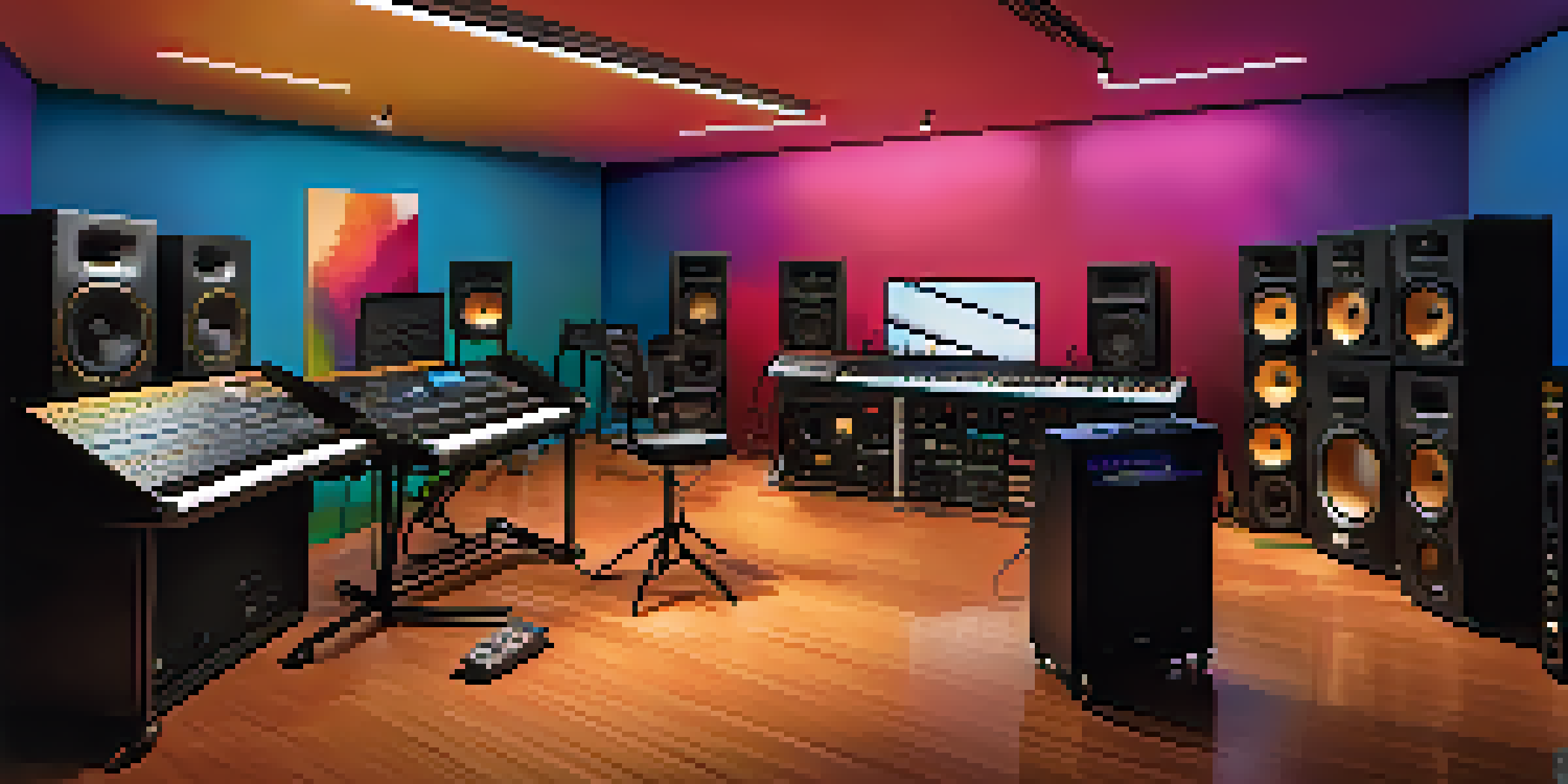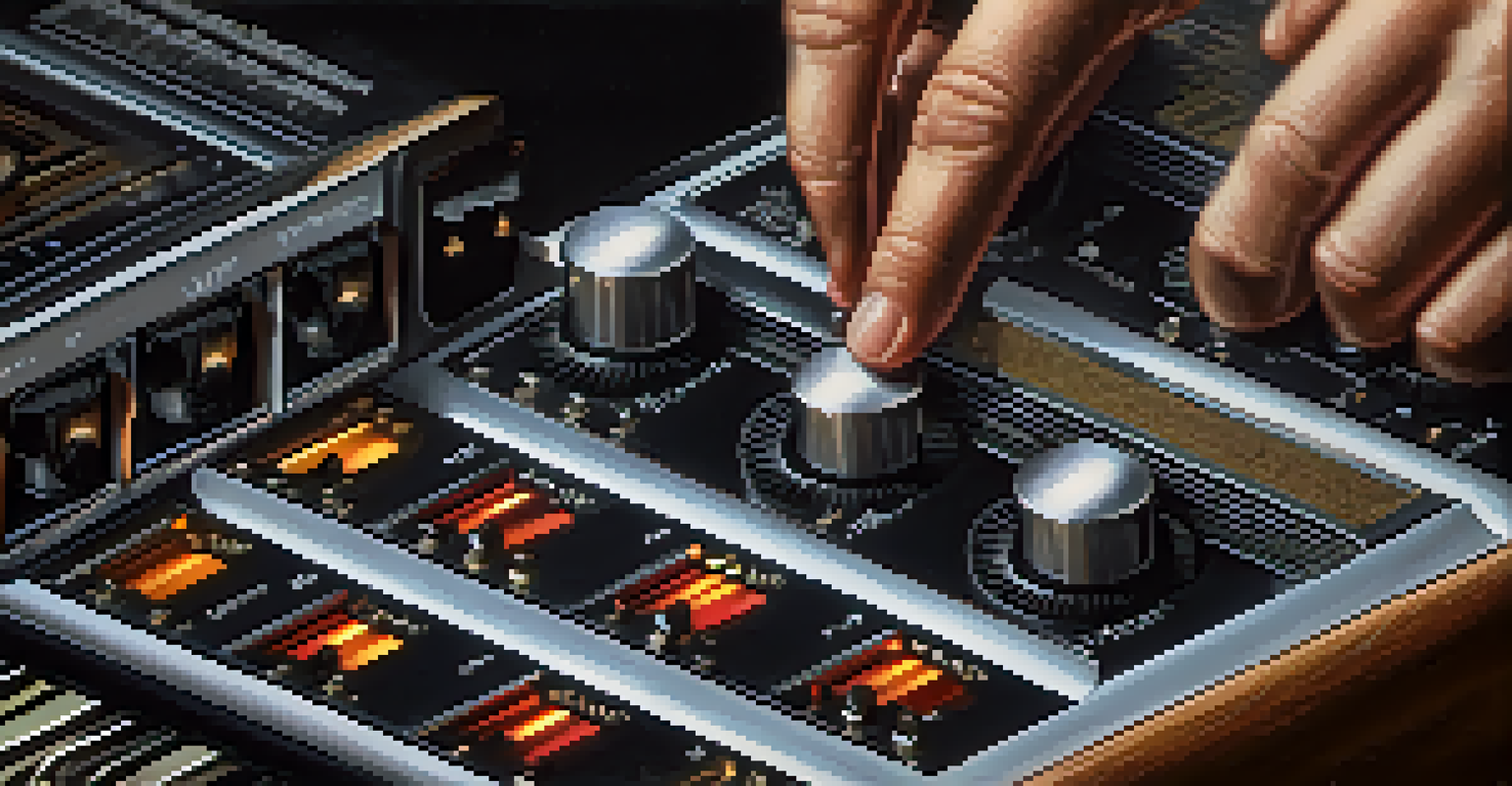Understanding Audio Effects: Enhancing Your Music Production

What Are Audio Effects and Why They Matter in Music
Audio effects are tools that modify sound, helping to create depth and texture in your music. They can transform a simple recording into a rich auditory experience, making them essential for any producer. Think of them as the spices that enhance a good meal; without them, the music can taste bland.
Music is the shorthand of emotion.
These effects can range from reverb and delay to distortion and compression. Each one serves a unique purpose, allowing you to manipulate sound in various ways. For example, reverb adds a sense of space, making it feel like your music was recorded in a grand hall.
Understanding how to use these effects effectively can elevate your productions and help you craft your unique sound. Just like mastering a recipe takes practice, so does mastering audio effects—both require patience and experimentation.
Types of Audio Effects: An Overview
Audio effects can be broadly categorized into time-based effects, dynamic effects, and tonal effects. Time-based effects, such as delay and reverb, create the illusion of space and depth, while dynamic effects like compression and limiting control the loudness of your tracks. Tonal effects, including equalization and distortion, enhance the frequency spectrum of your audio.

For instance, while a compressor reduces the dynamic range and ensures your vocals sit well in the mix, an equalizer helps you boost or cut specific frequencies to make an instrument shine. Understanding these categories can help you choose the right effects for your sound.
Audio Effects Enhance Music Depth
Audio effects like reverb and delay enrich recordings, making them more engaging and immersive.
Moreover, combining different types of effects can yield fascinating results. Just like blending colors in a painting, merging these audio effects can create a unique sonic palette that reflects your artistic vision.
Understanding Reverb: The Sound of Space
Reverb simulates the natural echo that occurs in various environments, from small rooms to vast cathedrals. It adds warmth and depth to sounds, making them feel more alive and engaging. Imagine singing in a shower—the sound resonates beautifully, creating a rich, full tone.
The best music is essentially there to provide you something to face the world with.
In music production, reverb can help blend instruments and vocals, giving them a cohesive feel. However, too much reverb can muddy your mix, so finding the right balance is key. Experimenting with different types of reverb can help you discover what best suits your track.
When applied tastefully, reverb can evoke emotion and set the mood for your music. Whether you're aiming for an intimate vibe or a grand atmosphere, understanding how to manipulate reverb will greatly enhance your productions.
Delving into Delay: Creating Depth and Echo
Delay is another powerful audio effect that creates echoes of sounds at set intervals. It can add depth to a mix and create rhythmic interest, making it a favorite among music producers. Think of it as the sound bouncing off walls—each repetition contributes to the overall texture.
There are various types of delay, including slapback, tape, and ping-pong, each offering a different sonic flavor. For example, slapback delay gives a quick echo that can make vocals sound punchy, while ping-pong delay alternates between left and right channels, creating a spacious effect.
Compression Controls Sound Dynamics
Using compression helps balance volume levels in a mix, ensuring clarity and consistency across all elements.
Incorporating delay into your tracks allows you to craft intricate soundscapes that draw listeners in. By adjusting the feedback and time settings, you can tailor the delay to suit the mood of your music.
The Role of Compression: Controlling Dynamics
Compression is a crucial effect used to manage the dynamic range of your audio. By reducing the volume of loud sounds and boosting softer ones, compression ensures that every element in your mix is heard clearly. Think of it as a safety net that keeps your performance balanced and polished.
In music production, compression helps to maintain consistency in volume, making your tracks more radio-friendly. For instance, compressing a vocal track can help it stand out in the mix, ensuring it doesn't get lost among the instruments.
Additionally, compression can shape the sound of your instruments, adding punch to drums or warmth to guitars. Mastering this effect can significantly improve the professional quality of your productions.
Exploring Equalization: Shaping Your Sound
Equalization, or EQ, allows you to adjust the balance of different frequencies in your audio. This effect is essential for enhancing clarity and ensuring each element in your mix occupies its own space. Imagine polishing a diamond; EQ helps to bring out the best facets of your sound.
Using EQ effectively can help eliminate muddiness in your mix by cutting unwanted frequencies. For example, reducing low frequencies on a vocal track can make it clearer without losing its warmth. Conversely, boosting certain frequencies can add character and presence to your instruments.
Experimentation Leads to Unique Sound
Exploring different audio effects allows producers to develop their distinct sound and creative style.
Understanding how to use EQ can transform your music, making it more polished and professional. With practice, you'll learn to recognize which frequencies to enhance or cut, allowing you to craft the perfect sound.
Creative Effects: Distortion, Flanger, and More
Beyond the fundamental effects, creative effects like distortion, flanger, and phaser can add unique textures and character to your sound. Distortion, often associated with electric guitars, adds grit and warmth, making it a staple in rock and blues music. It’s like adding a bold seasoning to your dish, bringing out strong flavors.
Flanger and phaser create swirling, whooshing effects that can make your audio feel dynamic and alive. These effects work by mixing the original sound with a delayed version of itself, creating a sense of movement. They can be particularly effective on synths and guitars, adding a surreal quality to your music.

Incorporating these creative effects allows you to experiment and push the boundaries of your sound. By embracing the unexpected, you can create a signature sound that sets your music apart.
Final Thoughts: Experiment and Find Your Sound
Understanding audio effects is a journey that combines art and science. As you experiment with different effects, you'll develop a better sense of how they can enhance your music. Remember, there are no strict rules—creativity thrives in exploration.
Start by applying these effects to your tracks and listen closely to how they change the overall sound. Don’t be afraid to try out unconventional combinations; sometimes the most unique sounds come from happy accidents. Think of it as a musical playground where you can test your ideas.
Ultimately, mastering audio effects is about finding your voice as a producer. With time and practice, you’ll discover how to use these tools to tell your musical story, creating captivating experiences for your listeners.